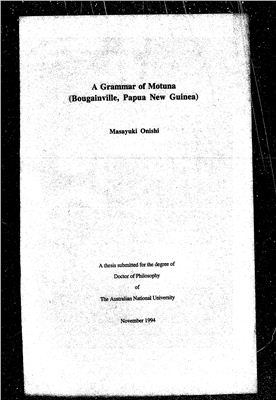Onishi, Masayuki (1994). A grammar of Motuna (Bougainville, Papua
New Guinea). PhD thesis, Australian National University.
This thesis is a descriptive grammar of Motuna, aNon-Austronesian language spoken by several thousand people in the south-westem part of Bougainville (called Siwai), Papua New Guinea. It belongs to the Buin Family of the Easte Bougainville stock, in the Bougainville Phylum. This grammar is based on the analysis of narrative texts provided by four speakers of the standard Motuna. Motuna is a both head and dependent marking agglutinati~e language with complex morphology. Like most Non-Austronesian languages in Papua NewGuinea, it is verb final, and has medial and non-medial verbal categories. In additon, verbs have basic voice distinction between active and middle voices, and have extensive tense/aspect/ mood categories. Nouns have six genders and are also classified by fifty-one classifiers.
Chapter 1 discusses the typological characteristics, as well as the genetic relations and dialectal variations of Motuna. It also briefly summarises previous work done on this language, and provides the scope and data base of this thesis. Chapter 2 deals with phonetics, phonology and orthography. It includes an introduction to morphophonemics which will be discussed fully in later chapters, particularly in Chapter 4 (nouns), Chapter 8 (classifiers, numerals and the 'all' quantifier), and Chapter 13 (verbal morphology). Chapter 3 outlines the word-classes and the clausal syntax of this language. Chapters 4 - 9 deal with the mopho-syntax of all the word classes except for verbs, participles and verbal nouns. Chapter 10 discusses the inteal structure of the NP, andChapter 11 possessive, kinship and other constructions. Chapter 12 outlines the morpho-syntax of verbs. I give a gist of verbal morphology in this chapter, so that readers may skip Chapter 13 which is a lengthy discussion of complicated verbal morphology. Chapter
14. discusses valency of verbs including valency-changing derivations (stimulative, causative, applicative and reciprocal). Chapter 15 deals with tense/aspect/mood. Chapter 16 deals with two word classes derived from verbs, verbal nouns and participles. Chapter 17 discusses the interclausal relations in Motuna, mainly chaining of medial verbs and relative clauses. Finally, three narative texts of this language are provided in Appendix.
This thesis is a descriptive grammar of Motuna, aNon-Austronesian language spoken by several thousand people in the south-westem part of Bougainville (called Siwai), Papua New Guinea. It belongs to the Buin Family of the Easte Bougainville stock, in the Bougainville Phylum. This grammar is based on the analysis of narrative texts provided by four speakers of the standard Motuna. Motuna is a both head and dependent marking agglutinati~e language with complex morphology. Like most Non-Austronesian languages in Papua NewGuinea, it is verb final, and has medial and non-medial verbal categories. In additon, verbs have basic voice distinction between active and middle voices, and have extensive tense/aspect/ mood categories. Nouns have six genders and are also classified by fifty-one classifiers.
Chapter 1 discusses the typological characteristics, as well as the genetic relations and dialectal variations of Motuna. It also briefly summarises previous work done on this language, and provides the scope and data base of this thesis. Chapter 2 deals with phonetics, phonology and orthography. It includes an introduction to morphophonemics which will be discussed fully in later chapters, particularly in Chapter 4 (nouns), Chapter 8 (classifiers, numerals and the 'all' quantifier), and Chapter 13 (verbal morphology). Chapter 3 outlines the word-classes and the clausal syntax of this language. Chapters 4 - 9 deal with the mopho-syntax of all the word classes except for verbs, participles and verbal nouns. Chapter 10 discusses the inteal structure of the NP, andChapter 11 possessive, kinship and other constructions. Chapter 12 outlines the morpho-syntax of verbs. I give a gist of verbal morphology in this chapter, so that readers may skip Chapter 13 which is a lengthy discussion of complicated verbal morphology. Chapter
14. discusses valency of verbs including valency-changing derivations (stimulative, causative, applicative and reciprocal). Chapter 15 deals with tense/aspect/mood. Chapter 16 deals with two word classes derived from verbs, verbal nouns and participles. Chapter 17 discusses the interclausal relations in Motuna, mainly chaining of medial verbs and relative clauses. Finally, three narative texts of this language are provided in Appendix.

